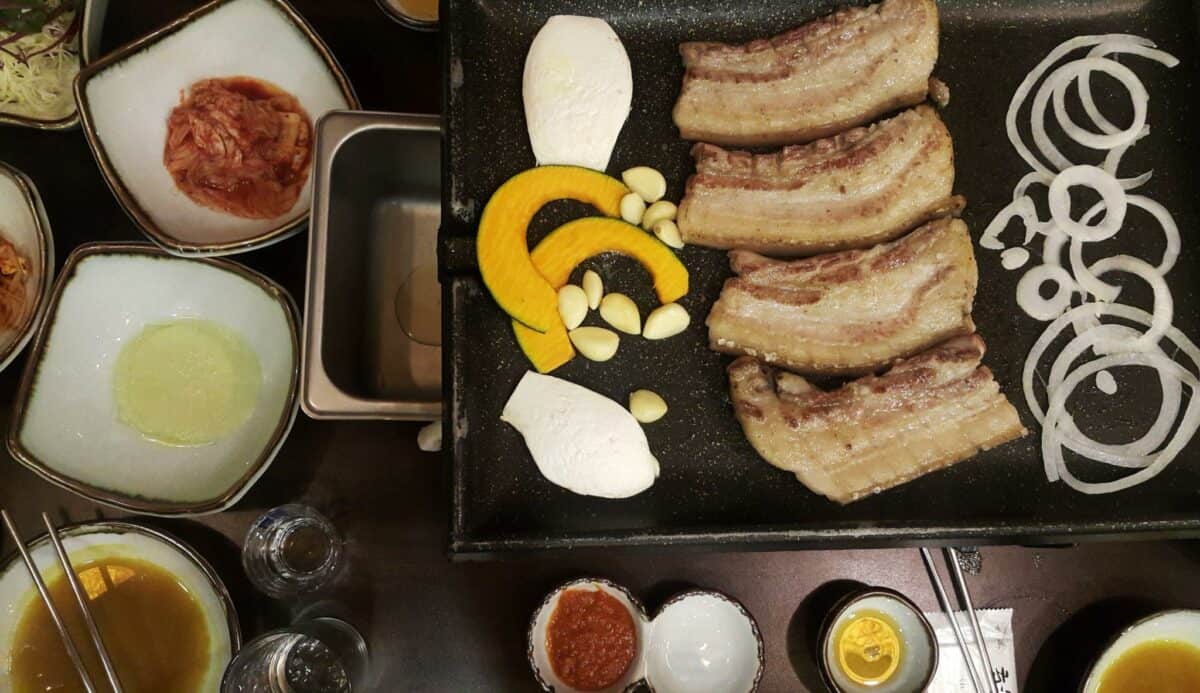
Easy Korean BBQ at Home (KBBQ)
A detailed list of ingredients for KBBQ at home, plus step-by-step instructions for making Korean barbecue at home without breaking a sweat (or the bank!).
Print
Pin
Servings: 8
Equipment
- 4-5 serving tongs one for each meat
- 4 platters for the grilled meats
- 1 large bowl for salad greens
- 3 small-medium bowls for banchan
- 8 Chopsticks
- 8 spoons
- 8 chopstick rests (optional)
- 8 small plates
- 8 sauce dishes
- Portable Stove or Tabletop induction stove
- Cast Iron Grill pan or Griddle (plus 1-2 changes of grill pan, depending on how much & what types of meats you'll grill)
- 2 Kitchen Shears
- 8 Shot Glasses and/or Cups
Ingredients
- ½ Kg. (16oz.) Dak Galbi marinated chicken thighs, boneless is best
- 1 Kg. (16oz.) Samgyeopsal non-marinated pork strips or preferred pork cut that hasn’t been marinated
- 1 Kg. (32-34oz.) Bulgogi marinated beef strips or preferred beef cut that has been pre-marinated
- ½ Kg. (16oz.) Ggot Deungsim non-marinated premium cut of meat for that something extra for the evening
- ½ Kg. (8oz.) uncooked rice or 2 pounds cooked rice
- ¼ Kg. (8oz.) Spring Onions plus 2 tsps. gochugaru, 1 Tbsp. toasted sesame seeds apart from pantry ingredients vinegar, soy sauce, and sugar
- ¼ kilo (8oz.) Fresh Garlic for the Spring Onion Salad and to grill or eat raw
- 1 large bag of Fresh Kimchi
- 1 large tub of Marinated Spinach
- 1 large tub of Soya Bean Sprouts or Stir-fried Fish Cake
- 1 bag of Lettuce or other Greens butter, iceberg, Romaine, bibb, or perilla leaves
Instructions
The day before:
- Prepare your meats. If anything needs to be marinated, do this a day prior, ideally the evening before. You can make your own marinade or buy any of the available marinades from the Korean grocery store.
- Cook or purchase side dishes ahead of time.
- Place soju and/or beer in the fridge to chill.
Two hours before:
- Prepare the vegetables by washing, rinsing, drying, and cutting them.
- Lay out the ban chan (side dishes) in small serving ware.
- Prepare the sauces. You can serve them in their container or ladle them in cute ceramic bowls for everyone to help themselves, buffet style. Likewise, you may portion them individually and put them in front of each place setting.
- Plate your meats (separately, to prevent cross-contamination). If you’re using bone-in meats, be sure to place ‘bone bowls’ evenly on the table so that everyone has a place to put their spent ends.
- Set the table, stacking small plates, chopsticks and spoons.
- Prepare your grill or hot plate, opening the windows if you’re inside the house, then brush the grill with oil.
- Cook rice and portion it out or put it in a large bowl.
To cook the KBBQ:
- Turn on the grill to medium, then brush the grill with oil if you haven't already. When the grill plate is hot, use a fatty meat part or an onion to spread the oil evenly so that the meat will not stick to the pan.
- Put your vegetables on the grill first because they take the longest to cook. Then add some meat slices. Start with one kind at a time. Cook the non-marinated meats first, and end with the marinated varieties to minimize smoke. Arrange the meat pieces on the grill, making sure they're evenly spaced. You can cut large slabs of meat before or after cooking, depending on how you prefer your meats.
- When cooking thin slices of meat, like bulgogi, leave them alone for a full minute before you start to flip. This allows the juice to lock in the meat; you’re not meant to move them around like when you’re sauteing.
- When you notice the top of your meat is starting to sweat or slightly starts to become charred (only recommended for extremely fatty cuts), you can flip them. Don't be that person at the table who flips their meat more than three times - Koreans firmly believe that grilled meats should be left alone to cook nicely. Otherwise, your juicy cuts of beef, pork, or chicken will become rubbery jerky.
- After another minute, check to see if your meat is cooked through. If you see that it needs more time, flip it again a final time. When cooked, the meat has a nice char and it’s time to take the pieces off the grill.
- Portion the meat into small plates by using kitchen shears to cut them up. You can cut them directly onto a platter or serve onto individual plates. If there are burnt pieces, you can snip them off at this point, too. If you’re using bone-in meats, you can snip these directly into the bone bowls. It’s best to enjoy K-BBQ as soon as they’re cooked so don’t cook a lot at one time. This also keeps the grill pan from emitting too much smoke.
- Continue this process with the rest of the meats; it’s good to have a back up hot or grill plate if it gets too smoky. If you have a large enough grill, you can set aside some meat pieces on the edges to keep warm, and do the same with basically any vegetable.
Notes
See the post for more detailed tips on what to prepare the day before and the morning or evening-of.
Best Sauces for KBBQ:
- A bottle of good Sesame Oil
- Kosher Salt
- Ground Black Pepper
- Ssamjang
- Gochujang Sauce
- Kyeoja (Sweet Mustard Sauce)
- Sweetened Soy Sauce